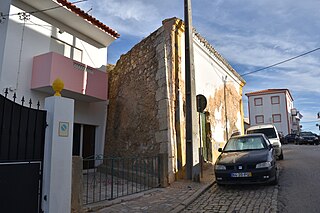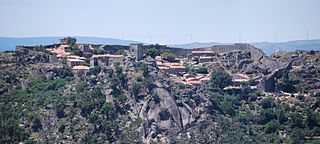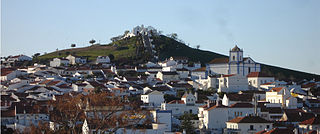
Alandroal is a municipality in the Portuguese district of Évora located on the eastern frontier with Spain along the right margin of the Guadiana River in the Central Alentejo region. It is located 341 metres (1,119 ft) above sea level, northeast of Évora and southeast of Estremoz. The population in 2011 was 5,843, in an area of 542.68 km2.

The Fort of São João do Arade, sometimes referred to as the Castle of Arade, is a medieval fortification situated in the civil parish of Ferragudo in the Portuguese Algarve municipality of Lagoa.

The Castle of Carrazeda de Ansiães, normally shortened to Castle of Ansiães, is a medieval castle in the civil parish of Lavandeira, municipality of Carrazeda de Ansiães of Portugal.

The Castle of Campo Maior is a medieval military fortification, in the civil parish of São João Bapista, municipality of Campo Maior, part of a first line of defense in the Portuguese Alentejo, oriented towards Spain, in conjunction with the military forts of Ouguela, Elvas, Olivença and Juromenha. It is a walled bulwark of the modern era, highlighted by a Renaissance-era window in the northern tower of the castle. It has been listed as a National monument since 1911.

The Castle of Evoramonte, alternately spelled Évora Monte or Évoramonte, is a Portuguese castle in the civil parish of Evoramonte, municipality of Estremoz in the former district of Évora. Initiated in 1160, in the Gothic period, it was enlarged in later centuries in the Manueline style. It was at this site that the Concession of Evoramonte on was signed on 26 May 1834, that ended Liberal Wars between the Liberal forces of Queen Maria II of Portugal and Absolutist armies of Miguel of Portugal. Since 1910, it has been listed as a Portuguese National monument.

Mexilhoeira Grande is a civil parish in the municipality (concelho) of Portimão in the southern Portuguese region of the Algarve. The population in 2011 was 4,029, in an area of 91.15 km².

The Castle of Terena is a castle in the civil parish of Terena in the municipality of Alandroal in the Portuguese subregion of Alentejo Central. Since 1946, it has been listed as a National monument.

The Castle of Alcantarilha is a medieval fortress and its remnant walls in Portugal, in the civil parish of Alcantarilha, municipality of Silves, in the Portuguese Algarve region of southwestern Iberia. It is a little-known monument, now in ruins, used for the protection of the people of the village and surrounding area from attacks by north African pirates.

The Castle of Aljezur is a medieval castle founded in the parish of Aljezur, in the municipality of the same name overlooking the Aljezur River. Excavations in the castle have discovered that the location was occupied during the Bronze and Iron Ages, while the parade grounds, habitational structures, and two silos date to the 12th and 13th centuries.

The Roman Ruins of Cerro da Vila are the remnants of a historical villa in the Algarve region of southern Portugal. Its vestiges lie in the vicinity of the resort and marina of Vilamoura, in the civil parish of Quarteira, municipality of Loulé Municipality.

The Castle of Alandroal is a medieval castle in the civil parish of Alandroal, São Brás dos Matos e Juromenha, municipality of Alandroal, Portuguese district of Évora, classified as a National Monument.

The Castle of Alcácer do Sal is a medieval castle located in the civil parish of Alcácer do Sal e Santa Susana, in the municipality of Alcácer do Sal, Portuguese district of Setúbal.

The Castle of Sortelha is a castle in the civil parish of Sortelha in the municipality of Sabugal in the Portuguese Centro region, classified as a National Monument.

The Castle of Alcanede, is a Portuguese medieval castle in civil parish of Alcanede, in the municipality of Santarém, in the Ribatejo district of Santarém.

The Castle of Aljustrel is a Portuguese medieval castle in civil parish of Aljustrel e Rio de Moinhos, in the municipality of Aljustrel, in the district of Beja.
The Castle of Barbacena is a former-medieval castle/fort in the civil parish of Barbacena e Vila Fernando, municipality of Elvas in the Portuguese Alentejo, classified as a Property of Public Interest.

The Castle of Vidigueira is a castle in the civil parish of Vidigueira in the municipality of Vidigueira in the Portuguese subregion of Baixo Alentejo. Although constructed in the first half of the 15th century, it is more commonly associated with the first of the Counts of Vidigueira: Vasco da Gama.

The Castle of Montalvão is a medieval castle in the civil parish of Montalvão, municipality of Nisa, in the Portuguese district of Portalegre.
The Castle of Seda is a medieval castle located in the civil parish of Seda, in the municipality of Alter do Chão, in the Portuguese district of Portalegre.
The Castro of Castelo Velho is a Chalcolithic settlement in the civil parish of Terena, municipality of Alandroal in the Alentejo Central area of the Portuguese Alentejo.






















